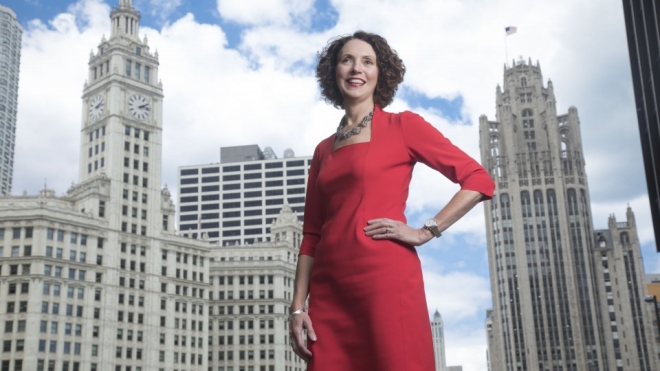After 25 great years leading the Chicago Architecture Center (CAC), Lynn Osmond recently moved on to become the new President and CEO of Choose Chicago, the city’s visitor and convention bureau. Her last day with CAC came in late April, but she will continue on with the AAO Board of Directors through this fall.
We took a moment to capture Lynn’s reflections and perspective gained through her many years engaging with people and organizations across our field.
1. How has the field of architecture organizations changed since you started 25 years ago?
It is wonderful to be seeing the proliferation of so many new architecture organizations in the States. No question the opening of AIA New York Center for Architecture in 2003 really accelerated this latest movement. However, I must say one of my early motivations for starting AAO was seeing the good work of the Architecture Center Network in the UK. I was so sorry to see that network close down. It goes to show what hard work it is to keep us moving forward.
2. What are some changes have you observed in the architecture field at large?
When I started there were so few women in professional practice and even fewer female high school students interested in architecture. Just looking at the CAC’s annual Newhouse Architecture Competition, it was primarily young men—mostly Eastern European or young Black men. There were very, very few Black or Latinx women. I am happy to say that has certainly shifted and we are now seeing a lot more diversity and especially more women in the architecture world. In our CAC programs, we are consistently seeing a notable presence of Black and Latinx young women in high school who are interested in pursuing design as their preferred occupation.
3. What do you see as your biggest accomplishments during your tenure that have helped advance CAC?
I will give you my top five…
- Of course, starting the Association of Architecture Organizations has been an important resource and connector for our immediate field.
- The development of our two main curricula “Schoolyards to Skylines” and “The Architecture Handbook” really put us on the map for design education, with hundreds of school districts throughout the US purchasing and using these educational supports.
- Launching Open House Chicago (with the support of Open House London and Open House Worldwide) has proven to be a staple for CAC and a major engine for jumpstarting community connections. I can’t imagine CAC without it!
- Expanding our docent programs and, in particular, the outside acknowledgement of the Chicago Architecture Center River Cruise Aboard Chicago’s First Lady as being the number one cruise in North America. It’s an accolade that, in a positive way, has really kept the pressure on us to deliver.
- The development of the Chicago Architecture Center. It took us some time, and was hardly a straight path to the finish line, but we finally got that permanent home Chicago deserves and that the organization can grow into.
4. As one of the founding forces behind AAO, how would you describe its purpose and value?
AAO’s primary purpose is to be a networking organization where staff at organizations as well as independent operators and interested individuals can share best practices and ideas. The concept is simple: as a collective we can make our field stronger and realize a greater public impact.
5. What do you see as some of the biggest opportunities and challenges facing architecture organizations over the next decade?
Architecture organizations continue to struggle with finding a steady funding model, and this means many organizations often soldier on in a sort of infancy cycle for an extended period. As a creative industry, we need to look at how we can secure a stable funding base to continue our work, as we are the group of organizations that can reach the masses and get people to look more closely at issues of urbanization and sustainability. If society is to implement the changes needed, it will come from an engaged public demanding those changes. It is an incredible opportunity, really: we are at a critical point in the timing and the discussion on climate action where change has to be made. I am disappointed more has not been done to move the 2030 challenge ahead in the States, but I remain cautiously optimistic in the talent and strength of the profession to inspire change.
6. In your new role at Choose Chicago, you will still be making the case for architecture. Where do you see the architecture and urban design field going in the future?
I am proud that now I can promote the importance of Chicago’s architectural legacy on a national and international scale. I very much believe in the power of design to change people’s lives and to shape cities for the better. I am excited that we are now focused on equity in our cities. As I said when I was at the CAC, “design can unite us, or design can divide us.” That’s a choice we make. For too long in Chicago, and in a lot of our urban areas, we have allowed design to divide us. It is time for us to leverage design as a power for good and make livable cities for all.

